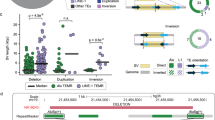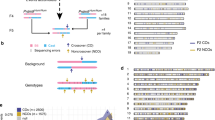Abstract
In humans, most meiotic crossover events are clustered into short regions of the genome known as recombination hot spots. We have previously identified DNA motifs that are enriched in hot spots, particularly the 7-mer CCTCCCT. Here we use the increased hot-spot resolution afforded by the Phase 2 HapMap and novel search methods to identify an extended family of motifs based around the degenerate 13-mer CCNCCNTNNCCNC, which is critical in recruiting crossover events to at least 40% of all human hot spots and which operates on diverse genetic backgrounds in both sexes. Furthermore, these motifs are found in hypervariable minisatellites and are clustered in the breakpoint regions of both disease-causing nonallelic homologous recombination hot spots and common mitochondrial deletion hot spots, implicating the motif as a driver of genome instability.
This is a preview of subscription content, access via your institution
Access options
Subscribe to this journal
Receive 12 print issues and online access
$209.00 per year
only $17.42 per issue
Buy this article
- Purchase on Springer Link
- Instant access to full article PDF
Prices may be subject to local taxes which are calculated during checkout




Similar content being viewed by others
References
Myers, S., Bottolo, L., Freeman, C., McVean, G. & Donnelly, P. A fine-scale map of recombination rates and hotspots across the human genome. Science 310, 321–324 (2005).
Jeffreys, A.J. & Neumann, R. Reciprocal crossover asymmetry and meiotic drive in a human recombination hot spot. Nat. Genet. 31, 267–271 (2002).
Jeffreys, A.J. & Neumann, R. Factors influencing recombination frequency and distribution in a human meiotic crossover hotspot. Hum. Mol. Genet. 14, 2277–2287 (2005).
The International HapMap Consortium. A second generation human haplotype map of over 3.1 million SNPs. Nature 449, 851–861 (2007).
Baudat, F. & de Massy, B. Cis- and trans-acting elements regulate the mouse Psmb9 meiotic recombination hotspot. PLoS Genet. 3, e100 (2007).
Neumann, R. & Jeffreys, A.J. Polymorphism in the activity of human crossover hotspots independent of local DNA sequence variation. Hum. Mol. Genet. 15, 1401–1411 (2006).
Jeffreys, A.J., Kauppi, L. & Neumann, R. Intensely punctate meiotic recombination in the class II region of the major histocompatibility complex. Nat. Genet. 29, 217–222 (2001).
Jeffreys, A.J., Murray, J. & Neumann, R. High-resolution mapping of crossovers in human sperm defines a minisatellite-associated recombination hotspot. Mol. Cell 2, 267–273 (1998).
Bi, W. et al. Reciprocal crossovers and a positional preference for strand exchange in recombination events resulting in deletion or duplication of chromosome 17p11.2. Am. J. Hum. Genet. 73, 1302–1315 (2003).
Reiter, L.T. et al. A recombination hotspot responsible for two inherited peripheral neuropathies is located near a mariner transposon-like element. Nat. Genet. 12, 288–297 (1996).
Lopez-Correa, C. et al. Recombination hotspot in NF1 microdeletion patients. Hum. Mol. Genet. 10, 1387–1392 (2001).
Van Esch, H. et al. Deletion of VCX-A due to NAHR plays a major role in the occurrence of mental retardation in patients with X-linked ichthyosis. Hum. Mol. Genet. 14, 1795–1803 (2005).
Raedt, T.D. et al. Conservation of hotspots for recombination in low-copy repeats associated with the NF1 microdeletion. Nat. Genet. 38, 1419–1423 (2006).
Lindsay, S.J., Khajavi, M., Lupski, J.R. & Hurles, M.E. A chromosomal rearrangement hotspot can be identified from population genetic variation and is coincident with a hotspot for allelic recombination. Am. J. Hum. Genet. 79, 890–902 (2006).
Andreassen, R. & Olaisen, B. De novo mutations and allelic diversity at minisatellite locus D7S22 investigated by allele-specific four-state MVR-PCR analysis. Hum. Mol. Genet. 7, 2113–2120 (1998).
Berg, I., Neumann, R., Cederberg, H., Rannug, U. & Jeffreys, A.J. Two modes of germline instability at human minisatellite MS1 (locus D1S7): complex rearrangements and paradoxical hyperdeletion. Am. J. Hum. Genet. 72, 1436–1447 (2003).
Buard, J., Bourdet, A., Yardley, J., Dubrova, Y. & Jeffreys, A.J. Influences of array size and homogeneity on minisatellite mutation. EMBO J. 17, 3495–3502 (1998).
Buard, J., Shone, A.C. & Jeffreys, A.J. Meiotic recombination and flanking marker exchange at the highly unstable human minisatellite CEB1 (D2S90). Am. J. Hum. Genet. 67, 333–344 (2000).
Jeffreys, A.J., Neil, D.L. & Neumann, R. Repeat instability at human minisatellites arising from meiotic recombination. EMBO J. 17, 4147–4157 (1998).
May, C.A., Jeffreys, A.J. & Armour, J.A. Mutation rate heterogeneity and the generation of allele diversity at the human minisatellite MS205 (D16S309). Hum. Mol. Genet. 5, 1823–1833 (1996).
Tamaki, K., May, C.A., Dubrova, Y.E. & Jeffreys, A.J. Extremely complex repeat shuffling during germline mutation at human minisatellite B6.7. Hum. Mol. Genet. 8, 879–888 (1999).
Stead, J.D. & Jeffreys, A.J. Allele diversity and germline mutation at the insulin minisatellite. Hum. Mol. Genet. 9, 713–723 (2000).
Lopes, J., Ribeyre, C. & Nicolas, A. Complex minisatellite rearrangements generated in the total or partial absence of Rad27/hFEN1 activity occur in a single generation and are Rad51 and Rad52 dependent. Mol. Cell. Biol. 26, 6675–6689 (2006).
Linnane, A.W. et al. Mitochondrial gene mutation: the ageing process and degenerative diseases. Biochem. Int. 22, 1067–1076 (1990).
Srivastava, S. & Moraes, C.T. Double-strand breaks of mouse muscle mtDNA promote large deletions similar to multiple mtDNA deletions in humans. Hum. Mol. Genet. 14, 893–902 (2005).
Coop, G., Wen, X., Ober, C., Pritchard, J.K. & Przeworski, M. High-resolution mapping of crossovers reveals extensive variation in fine-scale recombination patterns among humans. Science 319, 1395–1398 (2008).
Baumann, P., Benson, F.E. & West, S.C. Human Rad51 protein promotes ATP-dependent homologous pairing and strand transfer reactions in vitro. Cell 87, 757–766 (1996).
Vergnaud, G. & Denoeud, F. Minisatellites: mutability and genome architecture. Genome Res. 10, 899–907 (2000).
Bayes, M., Magano, L.F., Rivera, N., Flores, R. & Perez Jurado, L.A. Mutational mechanisms of Williams-Beuren syndrome deletions. Am. J. Hum. Genet. 73, 131–151 (2003).
Visser, R. et al. Identification of a 3.0-kb major recombination hotspot in patients with Sotos syndrome who carry a common 1.9-Mb microdeletion. Am. J. Hum. Genet. 76, 52–67 (2005).
Acknowledgements
We thank J. Lupski for help with compiling information on NAHR hot spots and G. Coop for discussion. We thank the Engineering and Physical Sciences Research Council (EPSRC), the Wolfson Foundation, the EU and the Wellcome Trust for financial support.
Author information
Authors and Affiliations
Contributions
S.M., P.D. and G.M. designed the study; S.M., A.A. and C.F. performed the analyses; S.M. and G.M. wrote the paper.
Corresponding author
Supplementary information
Supplementary Text and Figures
Supplementary Figures 1 and 2, Supplementary Tables 1–4, Supplementary Methods and Supplementary Note (PDF 318 kb)
Rights and permissions
About this article
Cite this article
Myers, S., Freeman, C., Auton, A. et al. A common sequence motif associated with recombination hot spots and genome instability in humans. Nat Genet 40, 1124–1129 (2008). https://doi.org/10.1038/ng.213
Received:
Accepted:
Published:
Issue Date:
DOI: https://doi.org/10.1038/ng.213
This article is cited by
-
Single-cell multi-omics sequencing of human spermatogenesis reveals a DNA demethylation event associated with male meiotic recombination
Nature Cell Biology (2023)
-
High-speed rail model reveals the gene tandem amplification mediated by short repeated sequence in eukaryote
Scientific Reports (2022)
-
Genetic variation in recombination rate in the pig
Genetics Selection Evolution (2021)
-
A Chinese pedigree with glucocorticoid remediable aldosteronism
Hypertension Research (2021)
-
Insights into variation in meiosis from 31,228 human sperm genomes
Nature (2020)



